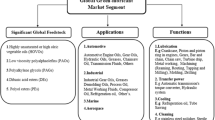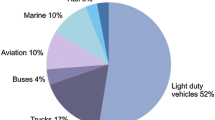Abstract
In response to the increasing environmental pollution concern and depleting petroleum reserves, bio-lubricants have received wide attention in replacement of mineral oil. Vegetable oils can be used as potential source of environmentally friendly bio-lubricants because of their biodegradability, renewability, and excellent lubrication performance. Present chapter introduces properties of several raw oils as well as oil extraction methods. Besides, vegetable oils also have some limitations such as poor oxidative stability and low-temperature fluidity, which can be improved through various modification methods such as direct transesterification or selective hydrogenation. Technology for modification of raw oils has also been described. Additionally, additives have a significant influence on the performance of the lubricating oil. The characteristic and applicability of different commonly used additives in bio-lubricant have been summarized in this chapter. Castor oil has a higher viscosity and a lower viscosity index compared with other vegetable oils. This chapter in particular describes the development of production process for the castor-based biodegradable lubricant.
Access this chapter
Tax calculation will be finalised at checkout
Purchases are for personal use only
Similar content being viewed by others
References
Adhvaryu A, Erhan SZ (2002) Epoxidized soybean oil as a potential source of high-temperature lubricants. Ind Crop Prod 15:247–254
Asadauskas S, Perez JM, Duda JL (1997) Lubrication properties of castor oil-Potential basestock for biodegradable lubricants. Lube Eng 53:35–40
Bongfa B, Peter AA, Barnabas A, Adeoti MO (2015) Comparsion of lubricant properties of castor oil and commercial engine oil. J Tribol 5:1–11
Birová A, Pavlovicová A, Cvengros J (2002) Lubricating oils base from chemically modified vegetable oils. J Synth Lubr 18:292–299
Canter N (2007) Special report: trends in extreme pressure additives. Tribol Lubr Technol 63:10–12
Charles D, WO 9835925 (1998) Method for preparing cleaved products from castor oil or derivatives thereof.
Chen B, Fang J, Dong L, Sun X, Wang J (2008) Enhancement of biodegradability of lubricants by biodegradation accelerants. Lubr Sci 20:311–317
Chen J (1999) Refining mixed oil. China Oils Fats 24:25–26 (in Chinese)
Demirbas A (2005) Biodiesel production from vegetable oils by supercritical methanol. J Sci Ind Res India 64:858–865
Demirbas A (2006) Biodiesel production via non-catalytic SCF method and biodiesel fuel characteristics. Energ Convers Manage 47:2271–2282
Fernández-Martinez J, Jimenez A, Dominguez J, Garcia JM, Garces R, Mancha M (1989) Genetic analysis of the high oleic acid content in cultivated sunflower (Helianthus annuus, L.). Euphytica 41:39–51
Gilbert EE (1941) The unique chemistry of castor oil. J Chem Educ 18:338–341
Grant I, Charne DG (1999) Brassica napus plant oil wherein the levels of oleic, alpha-linolenic, and saturated fatty acids are endogenously formed and simultaneously provided in an atypical highly beneficial distribution via genetic control. US Patent 5955623 21 Sep 1999
Grushcow J (2005) High oleic plant oils with hydroxy fatty acids for emission reduction. World Tribology Congress III, Washington, D.C. USA, 12–16 Sep 2005
Han H (2002) Viscosity index improvers for oil products. Sichuan Chem Ind 5:42–44 (in Chinese)
He LN, Dou XY, Ye F (2009) Phenol-free process for Sebacic acid production. CN 101367719 18 Feb 2009
He LN, Dou XY, Gao YS, Ye F (2011) Biomass-based energy: castor-derived biodegradable lubricate from laboratory to pilot plant. Prep Pap Am Chem Soc Div Fuel Chem 56:15–16
Kalam MA, Masjuki HH, Varman M, Liaquat AM (2011) Friction and wear characteristics of waste vegetable oil contaminated lubricants. Int J Mech Mater Eng 3:431–436
Kodali DR (2002) Process for modifying unsaturated triacylglycerol oils: resulting products and uses thereof. US Patent 6420322 16 July 2002
Kodali DR, Nivens SC (2001) Transesterified oils. US Patent 6278006 B1 21 Aug 2001
Koh MY, Ghazi TIM, Idris A (2014) Synthesis of palm based biolubricant in an oscillatory flow reactor (OFR). Ind Crop Prod 52:567–574
Li B, Wang X, Liu W, Xue Q (2006) Tribochemistry and antiwear mechanism of organic-inorganic nanoparticles as lubricant additives. Tribol Lett 22:79–84
Logan RL, Udeshi SV (2002) Method for preparing sebacic acid and octanol-2. US Patent 6392074B1 21 May 2002
Miller JF, Zimmerman DC, Vick BA (1987) Genetic control of high oleic acid content in sunflower oil 1. Crop Sci 27:923–926
Mobarak HM, Niza Mohamad E, Masjuki HH, Kalam MA, Al Mahmud KAH, Habibullah M, Ashraful AM (2014) The prospects of biolubricants as alternatives in automotive applications. Renew Sust Energ Rev 33:34–43
Naughton FC (1974) Production, chemistry, and commercial applications of various chemicals from castor oil. J Am Oil Chem Soc 51:65–71
Ogunniyi DS (2006) Castor oil: a vital industrial raw material. Bioresour Technol 97:1086–1091
Salih N, Salimon J, Yousif E, Abdullah BM (2013) Biolubricant basestocks from chemically modified plant oils: ricinoleic acid based-tetraesters. Chem Cent J 7:128–140
Schneider MP (2006) Plant-oil-based lubricants and hydraulic fluids. J Sci Food Agr 86:1769–1780
Silva JACD, Habert AC, Freire DMG (2013) A potential biodegradable lubricant from castor biodiesel esters. Lub Sci 25:53–61
Sun LJ (2007) High yield cultivation techniques of hybrid castor. J Seed Ind Guid 4:20–21 (in Chinese)
Tao DH (2003) Ye B (2003) Modified castor lubricants and preparation methods. CN Pat 1424387:18 (in Chinese)
Todd LK, Brajendra KS, Kenneth MD, Sevim ZE (2007) Adsorption behavior of epoxidized fatty esters via boundary lubrication coefficient of friction measurements. Chem Eng Commun 194:1065–1077
Tu G (2001) Refining technology of mixed castor oil. China oils and fats 26:40–43 (in Chinese)
Wagner H, Luther R, Mang T (2001) Lubricant base fluids based on renewable raw materials: their catalytic manufacture and modification. Appl Catal A-Gen 221:429–442
Xiao CL (2000) Synthesis and properties of zinc dialkyl aromatic dithiophosphates. Chem Eng 1:14–15 (in Chinese)
Wu X, Zhang X, Yang S, Chen HG, Wang DP (2000) The study of epoxidized rapeseed oil used as a potential biodegradable lubricant. J Am Oil Chem Soc 77:561–563
Yan XP, He BL, Zhang J, Liu HF (2005) Modification of transition metal cations to polymer-stabilized platinum colloidal clusters in enantioselective hydrogenation of methyl pyruvate. Chin J Polym Sci 23:393–399
Zainal NA, Zulkifli NWM, Gulzar M, Masjuki HH (2018) A review on the chemistry, production, and technological potential of bio-based lubricants. Renew Sust Energ Rev 82:80–102
Zeng X, Wu H, Yi H, Ren T (2007) Tribological behavior of three novel triazine dervivative as additives in rapeseed oil. Wear 262:718–726
Zhang C, Liu H, Zhang P, Zhang Z (2014) Lubricant additives-colorful condiments. Chin J Nat 36:264–273 (in Chinese)
Zhu F, Fan W, Wang A, Zhu Y (2009) Tribological study of novel S-N style 1,3,4-thiadiazole-2-thione derivatives in rapeseed oil. Wear 266:233–238
Author information
Authors and Affiliations
Corresponding author
Editor information
Editors and Affiliations
Rights and permissions
Copyright information
© 2020 Springer Nature Singapore Pte Ltd.
About this chapter
Cite this chapter
Cao, Y., Wang, N., Fu, H., You, F., He, L. (2020). Technologies for Conversion Bio-Lubricant Production in Fatty Acids. In: Li, C., Xiao, Z., He, L., Serio, M., Xie, X. (eds) Industrial Oil Plant. Springer, Singapore. https://doi.org/10.1007/978-981-15-4920-5_7
Download citation
DOI: https://doi.org/10.1007/978-981-15-4920-5_7
Published:
Publisher Name: Springer, Singapore
Print ISBN: 978-981-15-4919-9
Online ISBN: 978-981-15-4920-5
eBook Packages: Chemistry and Materials ScienceChemistry and Material Science (R0)




